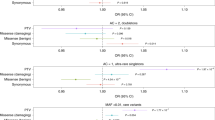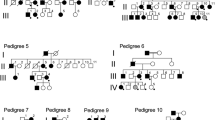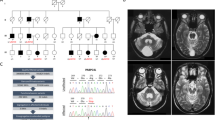Abstract
Polyglutamine expansion (PGE) encoded by a CAG repeat underlies eight inherited neurodegenerative diseases, among which is Huntington's disease. CAG expansion has also been reported in schizophrenia, suggesting a role for PGE. To investigate the potential role of PGE as a candidate for schizophrenia, we searched for PGE in nuclear families comprising a patient affected by childhood onset schizophrenia (COS, a rare and severe form of the disease) as a variation of the candidate gene approach for identifying susceptibility genes. We tested lymphoblastoid cell lines from COS patients (n = 32) by Western blot analysis with 1C2, a monoclonal antibody that specifically recognizes long polyglutamines. Eight of 11 unrelated black American COS patients showed a 60-kDa (approximately) band indicative of PGE. A strong 60-kDa band (suggestive of a large PGE) was detected in two of the eight positive patients. A weaker 60-kDa band (suggestive of a smaller and non pathogenic PGE) was detected in some unaffected parents or sibs of these two COS patients, and in six other black American COS patients. The strong and weak PGE signals were found to correspond to two different proteins. Unrelated black Americans unaffected by COS (n = 38) were negative for the strong 60-kDa PGE signal. Healthy white Americans (n = 53) were negative for both the strong and weak 60-kDa PGE signals. Two-dimensional gel analysis suggested that the strong PGE signal corresponds to an acidic (pI 4 approximately) protein and resulted in a more precise estimation (52–57 kDa) of its relative mass. This protein appeared to be not represented in Genbank, as suggested by the exclusion of several candidate CAG repeats. Our data suggest that this acidic protein might be a candidate for COS.
This is a preview of subscription content, access via your institution
Access options
Subscribe to this journal
Receive 12 print issues and online access
$259.00 per year
only $21.58 per issue
Buy this article
- Purchase on Springer Link
- Instant access to full article PDF
Prices may be subject to local taxes which are calculated during checkout
Similar content being viewed by others
Author information
Authors and Affiliations
Corresponding author
Rights and permissions
About this article
Cite this article
Morinière, S., Saada, C., Holbert, S. et al. Detection of polyglutamine expansion in a new acidic protein: a candidate for childhood onset schizophrenia?. Mol Psychiatry 4, 58–63 (1999). https://doi.org/10.1038/sj.mp.4000448
Received:
Revised:
Accepted:
Published:
Issue Date:
DOI: https://doi.org/10.1038/sj.mp.4000448
Keywords
This article is cited by
-
Anticipation and CAG•CTG repeat expansion in schizophrenia and bipolar affective disorder
Current Psychiatry Reports (2003)
-
Association of CAG repeat loci on chromosome 22 with schizophrenia and bipolar disorder
Molecular Psychiatry (2001)
-
Polyglutamine-containing proteins in schizophrenia: an effect of lymphoblastoid cells?
Molecular Psychiatry (2000)
-
Polyglutamine tracts in schizophrenia: gaining new insights
Molecular Psychiatry (2000)



